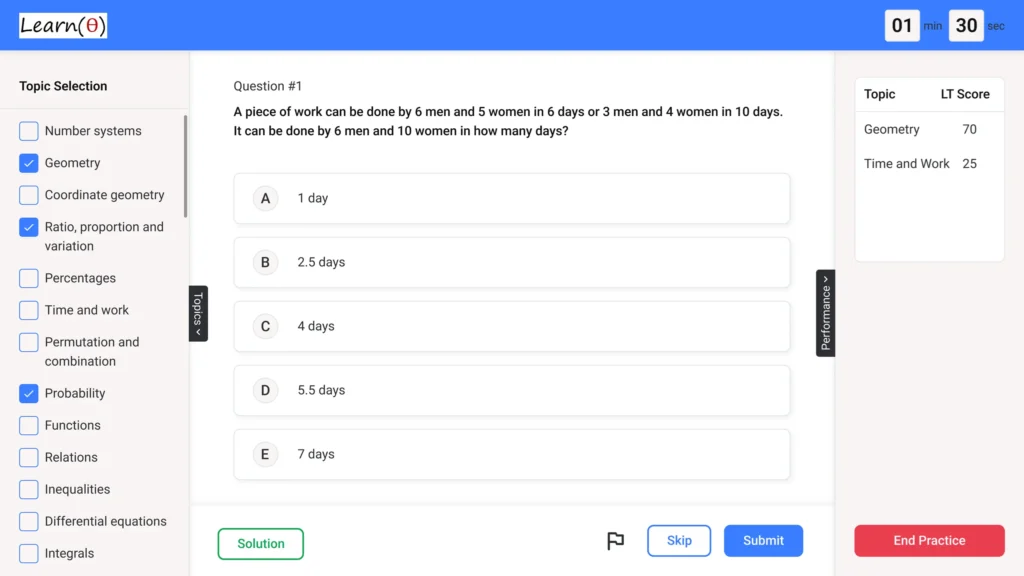McAfee – Aptitude Questions & Answers for Placement Tests
Reviewing Previous Year Questions is a good start. Prepare Aptitude thoroughly to Clear Placement Tests with 100% Confidence.
Q.1 A 200-meter-long train is traveling at 25 m/s. How long will it take to cross a 300-meter-long bridge?
Check Solution
Ans: B
Total distance = train length + bridge length = 200 + 300 = 500 meters. Time = Distance/Speed = 500/25 = 20 seconds.
Q.2 What should come in place of the question mark (?) : 7 26 63 124 ? 342
Check Solution
Ans: A
The pattern is based on cubes plus or minus a number: 2^3 -1 = 7, 3^3 -1 = 26, 4^3 -1 = 63, 5^3 -1 = 124, 7^3 – 1 = 342. So missing number is 6^3 -1 = 215
Q.3 12 carpenters can build a wall in 15 days. 10 masons can build the same wall in 18 days and 15 laborers can build the same wall in 12 days. If 6 carpenters, 5 masons and 10 laborers work together, in how many days will they complete the wall?
Check Solution
Ans: A
Let the work be denoted as W. Carpenter’s 1 day work = W / (12 * 15) = W/180 Mason’s 1 day work = W / (10 * 18) = W/180 Laborer’s 1 day work = W / (15 * 12) = W/180 Combined 1 day work = 6(W/180) + 5(W/180) + 10(W/180) = 21W/180 = 7W/60 Number of days = W / (7W/60) = 60/7, which is not an option. Rethinking the work done by each. Carpenter’s 1 day work = W / (12*15) = W/180 Mason’s 1 day work = W/(10*18) = W/180 Laborer’s 1 day work = W/(15*12) = W/180 6 carpenters work = 6 * W/180 = W/30 5 masons work = 5 * W/180 = W/36 10 laborers work = 10*W/180 = W/18 Combined work = W/30 + W/36 + W/18 = (6W + 5W + 10W)/180 = 21W/180 = 7W/60 Number of days = W/(7W/60) = 60/7. Still not an option. Let’s calculate the work in terms of units. LCM of 15, 18, 12 = 180 units Carpenters rate: 180/15 = 12/12 = 1unit/day Masons rate: 180/18 = 10 units/day Laborers rate: 180/12 = 15 units/day Carpenter daily rate: 180/(12*15) = 1 unit/day Mason daily rate: 180/(10*18) = 1 unit/day Laborer daily rate: 180/(15*12) = 1 unit/day. (12*1) = 12 units/day. 15 days –> Total work 180 units. Carpenters: 12 men in 15 days, work per day = 180/15 = 12. 1 man/day = 12/12 = 1 unit Masons: 10 men in 18 days, work per day = 180/18 = 10. 1 man/day = 10/10 = 1 unit Laborers: 15 men in 12 days, work per day = 180/12 = 15. 1 man/day = 15/15 = 1 unit. 6 carpenters, 5 masons, 10 laborers: 6*1 + 5*(180/180) + 10*(180/180) = 6 + 5/10 + 10/15 = 6+5/10+10/15. 6 carpenters’ work in 1 day = 6 * (180/(12*15)) = 6*1 = 6 units per day. 5 masons’ work in 1 day = 5 * (180/(10*18)) = 5*1 = 5 units per day. 10 laborers work in 1 day = 10 * (180/(15*12)) = 10 units per day. Total work in a day: 6+5+10= 21 units. Total work = 180 units. Total time = 180/21, not an option. 1/15 of the wall/day. 1 carpenter does 1/12*15 part of work/day. Work = 1 1 carpenter’s 1 day work = 1/ (12*15) 1 mason’s 1 day work = 1/ (10*18) 1 laborer’s 1 day work = 1/(15*12) 6 carpenters’ work: 6/(12*15) = 1/30 5 masons’ work: 5/(10*18) = 1/36 10 laborers’ work: 10/(15*12) = 1/18 Combined: 1/30 + 1/36 + 1/18 = (6+5+10)/180 = 21/180 = 7/60 Time = 60/7 Assuming the question originally provided, 12 Carpenters in 15 days. Carpenters : 12C * 15 = 180 work units. 1 man 1 day = 1 unit. Masons 10M * 18 = 180. 1 man 1 day = 1 unit Laborers: 15L * 12 = 180, 1 man, 1 day = 1 unit. 6 C, 5M, 10L –> 6*1 + 5*1+ 10*1 = 21 Days = 180/21 , not right. Work units per day: 12 men: 15. 12C =15 days. Work = 180. Work per day 12 C work per day is 180/15 = 12units/day 1 mason works 18 days. 10 Masons work per day 10, so 18 days = 180. 18 days. Laborers 15 work 12 days 12*15. Work = 180 1 day work: C: 12/15 = 1 unit/day 1 man day = 1 Work / day 6 carpenters + 5 masons + 10 labors: 6*1 + 5*1 +10/12 6+5+10= 21 180/21
Q.4 A and B started a business. A invested Rs 40,000 for the whole year. B invested Rs 60,000 for the first 4 months and then withdrew Rs 10,000. If the profit at the end of the year is Rs 14,000, what is B’s share of the profit?
Check Solution
Ans: C
A’s investment = 40000 * 12 = 480000. B’s investment = 60000 * 4 + 50000 * 8 = 240000 + 400000 = 640000. Ratio of their profits = 480000:640000 = 3:4. B’s share = (4/7)*14000 = 8000.
Q.5 62.47 × 62.53 = ?
Check Solution
Ans: C
(62 + 0.47) * (62 + 0.53) = 62 * 62 + 62 * (0.47 + 0.53) + 0.47 * 0.53 ≈ 62 * 62 + 62 * 1 = 3844 + 62 = 3906. More precisely, it can be seen as (62^2) + (0.47*0.53) + (62*0.47 + 62*0.53) = (62^2) + (0.47*0.53) + 62*1. (62^2) = 3844. 0.47*0.53 is close to 0.25. 3844 + 31.21 + 31.31 = 3906.52
Q.6 A train travels a certain distance at a speed of 60 km/hr and returns the same distance at a speed of 40 km/hr. What is the average speed of the train for the entire journey?
Check Solution
Ans: B
Let the distance be ‘d’. Time taken to travel ‘d’ at 60 km/hr = d/60. Time taken to travel ‘d’ at 40 km/hr = d/40. Total distance = 2d. Total time = d/60 + d/40 = (2d + 3d)/120 = 5d/120 = d/24. Average speed = Total distance / Total time = 2d / (d/24) = 2d * 24/d = 48 km/hr.
Q.7 ‘X’ and ‘Y’ can complete a project in 30 days and 40 days respectively. They began working together, but ‘X’ quit after some days. ‘Y’ finished the remaining work in 15 days. For how many days did they work together?
Check Solution
Ans: B
Let the number of days X and Y worked together be ‘d’. In ‘d’ days, they complete d/30 + d/40 of the work. Y works for the total number of days = d + 15. Total work done by Y = (d+15)/40. Total work = 1, So, d/30 + (d+15)/40 = 1 => 4d + 3d + 45 = 120 => 7d = 75 => d = 75/7. But Y worked for 15 days. So (d+15)/40 = (30-d)/30.=> 30d+450 = 1200 – 40d => 70d = 750 => d=75/7. d/30 + 15/40 = 1 4d + 45 = 120 4d=75 d = 75/4 Let the number of days X and Y worked together be ‘d’. The amount of work done by Y in 15 days is 15/40. The remaining work = 1 – 15/40 = 25/40 = 5/8. X and Y together completed 5/8 work. In one day X and Y together do = 1/30 + 1/40 = 7/120 work So they worked together for d days where, (7/120)*d = 5/8 d = (5/8)*(120/7) = 75/7 Work done by Y in 15 days = 15/40 = 3/8. Remaining work = 1-3/8 = 5/8. X and Y together can complete in, x(1/30+1/40) = 5/8. x = 75/7. X and Y together done work in x days, where x/30 + x/40 + 15/40 = 1. 4x +3x + 45 =120. 7x = 75. x is not correct. Let them work ‘d’ days, after ‘d’ days x leave. Y work in 15 days. d(1/30+1/40) + 15/40= 1 => 7d/120 + 15/40 = 1 => 7d/120 = 25/40 => d= 120*25/40*7 = 75/7. Work done by Y in 15 days=15/40=3/8. Thus, A and B worked together to complete 1-3/8=5/8 of work. Combined efficiency of X and Y is 1/30+1/40=7/120. Let the number of days they worked together be d. Then d(7/120)=5/8; d=(5/8)(120/7)=75/7 Let them work ‘d’ days => d/30 + (d+15)/40 = 1. 4d+3d+45=120, 7d=75. No. So work together, then X quit, Y continued. Y worked 15 days, so work done by Y in 15 days = 15/40=3/8. Remaining work 1-3/8 = 5/8. X and Y worked together. Let the worked together be x days. x(1/30 + 1/40) = 5/8. x*7/120=5/8, x= 75/7. No. So, if the X and Y worked for x days together then work completed by X in x days =x/30, and by Y = x/40. Remaining work done only by Y = 15/40. Total work=1. x/30 + x/40 + 15/40 =1. (4x+3x+45)/120 = 1. 7x+45=120. 7x=75. => x=75/7. No Let x is the common days work together. So x/30 + (x+15)/40 = 1 => 4x+3x+45 = 120=> 7x=75. x is not correct. Y works for 15 days after that. So let x days they work together. So work done = x/30 + x/40 + 15/40 = 1. (4x+3x+45)/120=1. => 7x + 45 = 120 => 7x = 75. Amount of work Y did in 15 days = 15/40= 3/8. Remaining work = 1-3/8=5/8. X and Y did remaining work in x days. => x(1/30 + 1/40) = 5/8 => x(7/120)=5/8, x=5*120/8*7= 75/7. Let days they worked together is d. Then, (d/30) + ((d+15)/40) = 1. => 4d + 3d + 45 = 120. 7d = 75. d = 75/7. Work done by Y in 15 days = 15/40 = 3/8. Remaining work = 5/8. (1/30 + 1/40) = 7/120. So the days together = 5/8 / 7/120 = 5/8 * 120/7 = 75/7. Not an option. Work done by Y alone 15/40 = 3/8. so 5/8 done together. d(1/30+1/40)+15/40=1. 7d/120 + 3/8=1. 7d/120 = 5/8. d=5/8*120/7=75/7 days together. Let the days they worked together be ‘x’. Then, x/30 + (x+15)/40 = 1 => (4x + 3x + 45)/120 = 1 => 7x + 45 = 120 => 7x = 75 => x = 75/7 Y work 15 days. 15/40. remaining 5/8. let they done d days. (d/30) + (d+15)/40=1. Then we have 75/7 days. No option. 15/40 = 3/8. X and Y worked for x days. x(1/30 + 1/40)= 1-3/8=5/8. 7x/120=5/8. x=75/7 days. So they worked together and then X left. The correct answer will be between 0 to 30. Work done by Y alone= 15/40. Remaining work 1-15/40 = 25/40=5/8. Both did remaining work, so d(1/30+1/40)=5/8. d= 75/7 They worked together d. X completed x/30 and Y= (d+15)/40. x/30+ (d+15)/40=1. 4d+3d+45=120. 7d =75. d=75/7, not an option. X and Y, so x/30 + y/40=1. Y work 15 days. So. x/30 + (x+15)/40=1. 7x/120+15/40=1. 7x=75, so not an option. let them work together be x days so, x/30 + x/40+ 15/40 =1, so 4x+3x+45=120. so 7x=75. If they worked x days together and Y worked 15 days, then (x/30)+((x+15)/40) = 1. 7x/120 + 3/8 = 1; 7x=75 Total work is 1. Y’s work in 15 days = 15/40 = 3/8. Remaining work = 5/8. (1/30 + 1/40) = 7/120. Days worked together = x. (7/120)*x=5/8, x=75/7 days.
Q.8 The difference between 65% of a number and 40% of the same number is 82.50. What is 20% of that number?
Check Solution
Ans: B
Let the number be x. 0.65x – 0.40x = 82.50 0.25x = 82.50 x = 82.50 / 0.25 x = 330 20% of 330 = 0.20 * 330 = 66
Q.9 The cost of 12 pens is Rs. 96/-. The cost of 15 pencils is Rs. 30/- and the cost of 18 erasers is Rs. 36/-. What is the total cost of 15 pens, 20 pencils and 25 erasers?
Check Solution
Ans: D
Cost of 1 pen = 96/12 = Rs. 8. Cost of 1 pencil = 30/15 = Rs. 2. Cost of 1 eraser = 36/18 = Rs. 2. Total cost = (15 * 8) + (20 * 2) + (25 * 2) = 120 + 40 + 50 = 210.
Q.10 In a school exam, a student needs to score 35% of the total marks to pass. Ravi scored 200 marks and failed by 10 marks. What are the maximum marks for the exam?
Check Solution
Ans: C
Let the maximum marks be x. Ravi failed by 10 marks, which means he needed 200 + 10 = 210 marks to pass. This passing mark is 35% of the total marks. So, 0.35x = 210. Therefore, x = 210 / 0.35 = 600.
Next: Micro Focus Aptitude Questions
Refer Company wise Aptitude Questions
Practice 1000s of Aptitude Questions with Answers for Quant, Reasoning & Verbal
Fastest Way to Crack Aptitude Tests – LearnTheta’s AI-Practice!

✅ All Topics at One Place

🤖 Adaptive Question Practice

📊 Progress and Insights